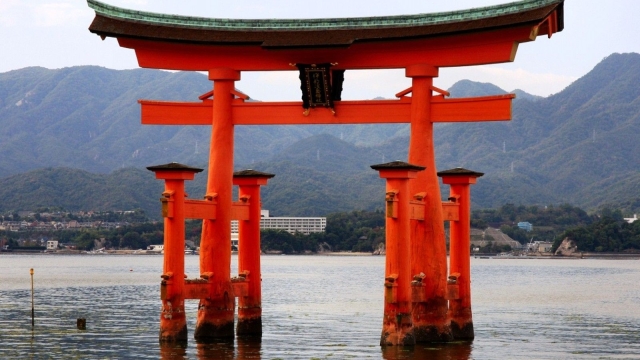
Shinto shrines, the sacred havens of Japan, stand as a testament to the profound connection between nature and spirituality. These enchanting sites invite visitors to immerse themselves in an ancient tradition that honors the kami, the spirits residing in everything from towering trees to tranquil streams. As one steps through the iconic torii gate that marks the entrance to a shrine, the bustling world outside fades away, replaced by an aura of serenity and reverence.
Each shrine is unique, embodying the rich tapestry of local beliefs and practices. Elaborate rituals, seasonal festivals, and the breathtaking beauty of their surroundings create an atmosphere filled with tranquility and reflection. Whether nestled among the serene forests or perched on the mountainside, shinto shrines offer a glimpse into a world where the sacred and the natural harmoniously coexist, inviting all to pause and listen to the whispers of the kami.
The Essence of Shinto Shrines
Shinto shrines are more than mere structures; they are sacred spaces that embody the spiritual beliefs and practices of the Shinto religion. Each shrine is dedicated to a specific kami, or spirit, and serves as a place for worship, reflection, and communion with the divine. The architecture of these shrines is deeply symbolic, often incorporating natural elements that highlight the connection between the physical world and the spiritual realm.
The entry to a Shinto shrine is often marked by a torii gate, which signifies the transition from the mundane to the sacred. Visitors are welcomed into an environment where nature plays a vital role, with trees, water, and stones carefully integrated into the shrine’s design. This harmony with nature reflects the Shinto reverence for the natural world, where each element is viewed as a manifestation of the kami’s presence.
At Shinto shrines, rituals and traditions are practiced to honor the kami and seek their blessings. Offerings of rice, salt, and sake are commonly made, and visitors may participate in purification rites to cleanse themselves before entering the hallowed grounds. This sense of community and continuity fosters a profound connection among worshippers, allowing them to engage with their heritage while experiencing the spiritual ambiance of the shrines.
Architectural Wonders
Shinto shrines are remarkable examples of traditional Japanese architecture, designed to harmonize with their natural surroundings. Often constructed using wood, these structures exhibit a simplicity that reflects the Shinto belief in the sacredness of nature. The use of natural materials enhances the connection between the shrine and its environment, allowing visitors to feel a sense of tranquility and reverence as they approach the sacred space.
One of the most iconic architectural features of Shinto shrines is the torii gate. This welcoming structure marks the transition from the mundane world to the sacred realm, often standing at the entrance of the shrine. Torii gates come in various styles and colors, with the vermillion hue being particularly popular, symbolizing protection and energy. Each torii is a statement of cultural significance, embodying the spirit of the kami that resides within the shrine.
The main building of a shrine, known as the honden, is typically elevated on pillars and features a thatched or tiled roof that curves gently upwards at the edges. This design is not only aesthetically pleasing but also practical, helping to protect the structure from the elements. Inside the honden, the kami is enshrined in a sacred space, emphasizing the importance of the spiritual connection that Shinto shrines foster. The architectural elements of these shrines serve to create a profound sense of peace and contemplation for all who visit.
Rituals and Offerings
At the heart of Shinto shrines, rituals and offerings play a vital role in connecting the faithful with the kami, or spirits, that inhabit the natural world. Visitors often begin their visit by purifying themselves at a chozuya, a water basin where they perform a ritual washing of their hands and mouth. This act symbolizes the removal of impurities, both physical and spiritual, preparing them to approach the divine with a clear heart and mind. The sound of flowing water and the serene environment create a peaceful atmosphere, inviting reflection and reverence.
Once participants feel ready, they proceed to the main hall of the shrine where they present their offerings. Common offerings include rice, sake, fruits, and flowers, each chosen to honor the kami. Followers may also write their prayers or wishes on wooden plaques known as ema, which are hung on racks within the shrine grounds as acts of devotion. These gestures reflect a deep respect for the kami, fostering a sense of community as individuals share their hopes and gratitude.
Seasonal festivals, known as matsuri, further elevate the spiritual experience at Shinto shrines. These vibrant celebrations often involve music, dance, and traditional performances that celebrate the kami and the cycles of nature. Participants engage in activities ranging from parades to elaborate displays of art, all designed to invoke blessings from the spirits. Through these rituals and offerings, the connection between the sacred and the everyday is emphasized, allowing individuals to partake in the ongoing dialogue with the kami.
Famous Shinto Shrines
Visiting a Shinto Shrine
Visiting a Shinto shrine offers a unique opportunity to immerse oneself in Japan’s spiritual heritage. As you approach the shrine, you will typically pass through a sacred torii gate, symbolizing the transition from the mundane to the sacred. This moment sets the tone for your visit, inviting feelings of reverence and tranquility. With stunning architecture and lush surroundings, each shrine is often a harmonious blend of nature and craftsmanship, making the experience visually captivating.
Once inside, there are several customs to observe that enhance your visit. It is customary to purify yourself at the chozuya, a water basin where visitors wash their hands and mouth before offering prayers. The act of purification is not just a ritual but a reflection of mindfulness as you prepare to connect with the kami, the spirits that reside within the shrine. After purifying yourself, you can engage in an offering, which typically involves tossing a coin into the offering box, bowing, clapping your hands, and making a silent prayer or wish.
The atmosphere at a Shinto shrine can vary throughout the year, reflecting the seasons and specific festivals. During these events, shrines may be bustling with vibrant colors, traditional music, and community gatherings. Whether visiting during a festive occasion or a quiet day, each experience at a Shinto shrine offers a moment of introspection and connection to nature, spirituality, and Japanese culture.

